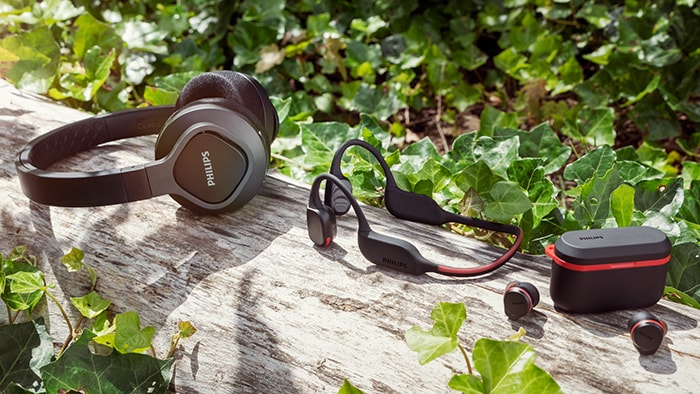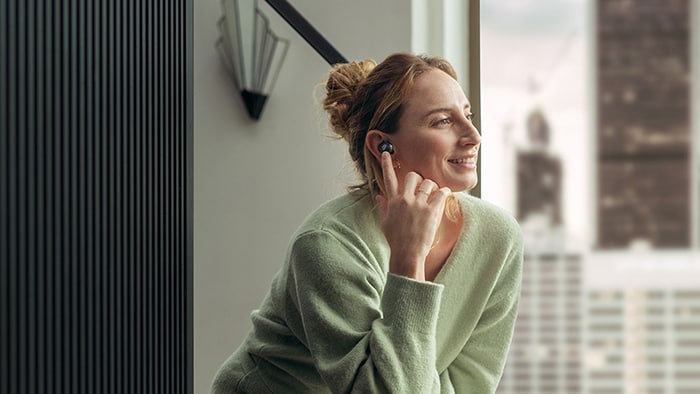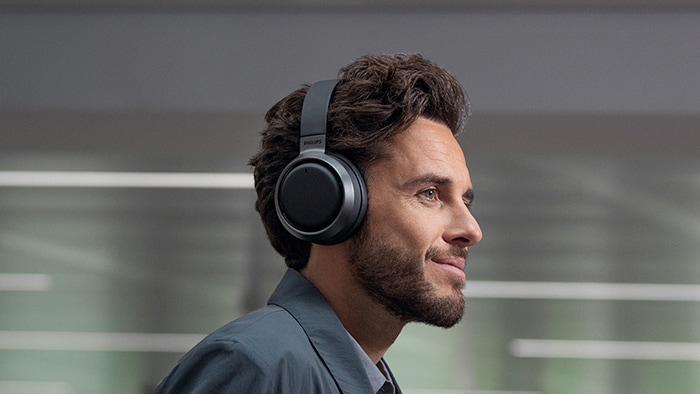How do noise canceling headphones work?
Have you ever found yourself wanting to turn down the noise around you so you can focus better on what you’re doing, or enjoy a quiet moment during a busy day? If you have, you’re not alone. If that promise appeals to you, then a pair of noise canceling headphones will likely bring you a lot of pleasure. The technology behind these modern-day marvels is constantly evolving, so just how do you go about finding the right pair for you? Read on to find out what noise cancellation is and how it works! After all, an informed decision is a good decision.
Urban environments especially are getting noisier, and noise canceling headphones promise to let you block unwanted noise so you can immerse in music—or simply enjoy some silence.
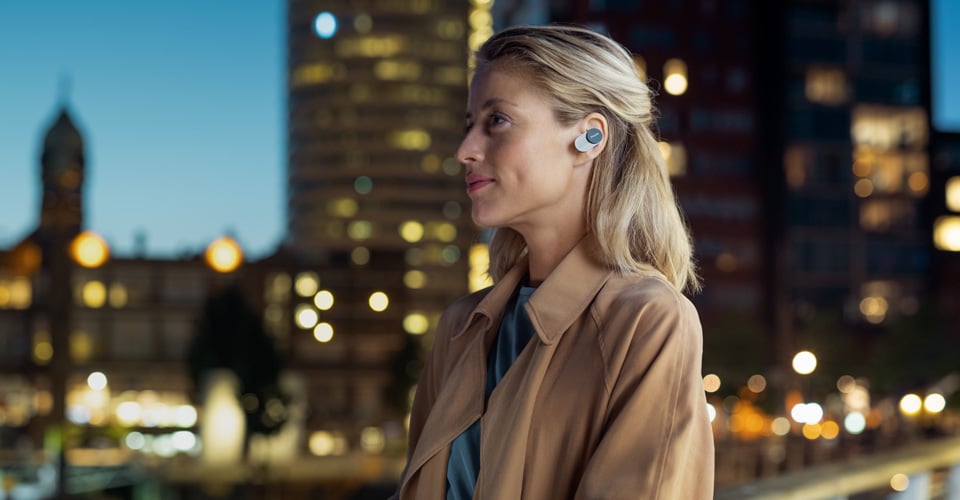
So what are noise canceling headphones?
If you travel or commute regularly, you’ve probably heard of noise canceling headphones already. Noise canceling headphones use a technology called ‘active noise cancellation’ (ANC) to block or reduce unwanted sounds from your environment, so you are better able to enjoy what you’re listening to. They’re a great way to disengage from the noisy environment of a train, or tune out the hum of a plane, and travel encased in a bubble of music (or create a space to listen to your favourite podcast). But they’re not just for people on the go. If you need to focus when working from home or studying—or you simply want to relax and immerse in your music—noise canceling headphones are worth your consideration. The hype around the tech is justified, especially now that active noise cancellation is no longer in its infancy.
Noise canceling headphones 101: A straight-up guide to the terminology
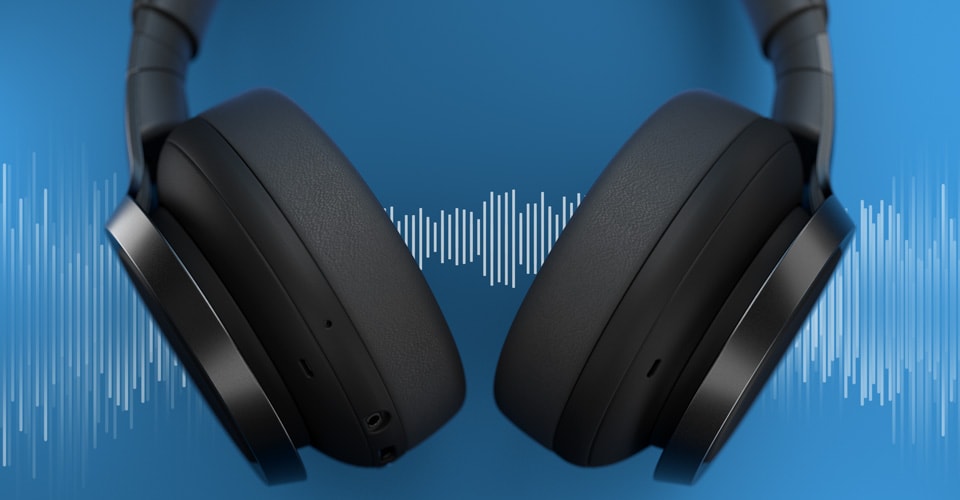
If you’re shopping for noise canceling headphones, you’ve probably already come across so many techy words and acronyms that you’re about ready to give up. We don’t blame you. There’s active noise cancellation (ANC)—and what about passive noise cancellation (PNC)? Or did you hear about ‘noise isolation’ yet? Perhaps more than any other headphone technology, it can feel like the benefits of noise cancellation are hidden behind jargon. Before we dive too deeply into the ways in which noise canceling headphones can turn the world into your own private listening haven, we’re going to make things a little clearer. Strap in. Let’s demystify all those ANCs and PNCs.
Active noise cancellation and noise canceling: there’s no difference!
Noise canceling and active noise cancellation (ANC) mean exactly the same thing. Both terms refer to the way headphones (or earbuds) use smart electronics to cancel out background and surrounding noises. This is done with mics and algorithms: the mics pick up the sounds from your environment, and the algorithms devise clever ways to cancel them out before you hear them.
Passive noise cancellation: it’s about physical design
Passive noise cancellation (PNC) or ‘noise isolation’ are when the physical design of your headphones seals out unwanted noise. The materials used—and the way in which the headphone ear cups cover your ear, or the earbuds sit in your ear—create a seal that reduces the noise you hear from your environment. It’s worth noting that ‘passive noise cancellation” is a bit of a misnomer because unwanted external noise is dampened rather than cancelled. That said, the damping is pretty effective. In fact, you can hear passive noise isolation in action for yourself by simply putting your hands over your ears! Do you notice how when you do this, outside noises become muffled? This is a very simple form of noise isolation.
Philips noise canceling headphones use both active noise cancellation and passive noise cancellation
At Philips, all our noise canceling headphones use a combination of active noise cancellation (ANC) and noise-isolating design, but we refer to them all as—simply—noise canceling headphones. There are differences between the Philips models, and we go into that below, but they all have one thing in common: you can turn ANC on or off. If you’re shopping for headphones and they claim to be noise canceling headphones, but you cannot turn the noise cancellation on or off, then they’re probably noise-isolating headphones. In other words, they probably rely only on passive noise cancellation, and not active noise cancellation.
Why noise canceling matters
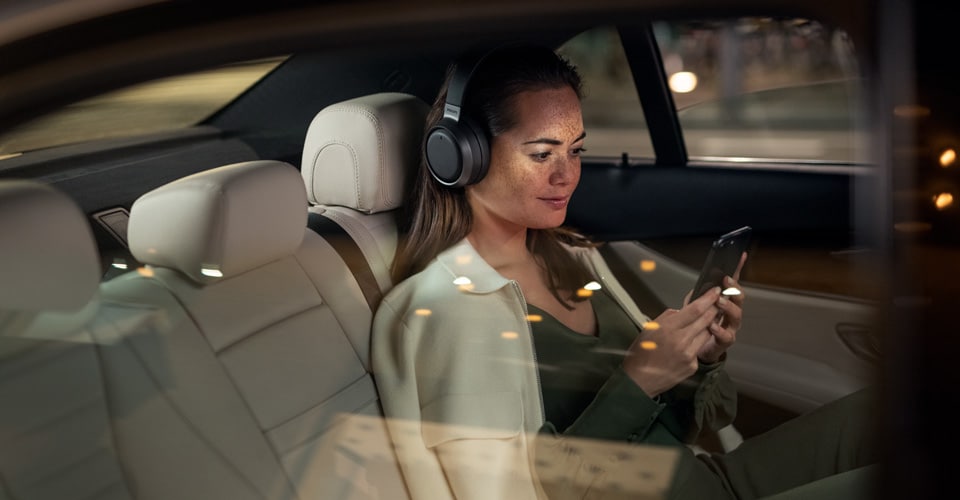
You get to enjoy your sounds without cranking up the volume and risking your hearing
Imagine you’re on the train, or the tram, travelling to work. It’s your oasis before you dive into the hurly-burly of the day. You want to immerse in your tunes or a podcast. But the noise of the tram, and all the people in it, means you can’t relax with your music. Or, worse, you have to crank up the volume really loud to mask everything else, so you risk damaging your hearing. This is where active noise cancellation (ANC) comes in. ANC technology was originally developed to help pilots concentrate by masking the noisy environment of a plane or helicopter cockpit—where it was vital that they clearly hear communications. So, you can see how this tech is already set up to solve the problem of your noisy commute!
A word about auditory masking and sound waves
Here’s the science part. A sound is made by a sound source (such as a headphone speaker/driver, or engine noise) disturbing the air in its immediate vicinity. This disturbance changes the air pressure, causing a sound wave to emanate from the source. We measure sound in decibels. Decibels are actually a measure of changes in air pressure (and therefore the intensity of sound waves), but it’s easier to just say this: the more decibels you measure, the louder the sound. When you’re wearing headphones, you hear what you’re listening to because the sound comes from a speaker (or ‘driver’ in headphone terminology) that’s extremely close to your ear. Because it’s close, the sound can be comparatively quiet (that’s why you can’t hear what somebody is listening to on their headphones if you’re on the other side of the room to them). However, if an external noise—like the sound of the train or airplane engine—is louder than your music, you won’t hear the music properly because the noise of the engine intrudes. In other words, the external noise is masking the sounds we want to hear with noise that we don’t. The sound waves of the engine are more powerful, so the engine produces more decibels than the sound coming from your headphones. More decibels always beat fewer decibels, so the external noise wins. If you’re not wearing noise canceling headphones, the only way to hear your music or podcast in this situation is to crank up the volume until it’s loud enough to fight back. Of course this is very bad for your ears. Pounding your eardrums with high decibel levels at nearfield distances is a pretty quick way to damage your hearing. If you are wearing noise cancelling headphones, you won’t need to dramatically increase the volume because the ANC system removes the outside noises that are masking what you want to hear. You’ll get to enjoy your music, podcast, or audiobook in peace—without blowing your eardrums. But how does the magic happen?
What’s that, you say… masking? To understand why noise cancelling headphones that use ANC can be vital for our auditory health, as well as our listening pleasure, we first need to understand a little concept called masking. When sound is masked, it’s concealed by other, louder sounds.
How do wireless noise canceling headphones cancel noise?
In truth, wired and wireless noise canceling headphones both use active noise cancellation (ANC) to cancel noise in the exact same way. The only difference between wired and wireless headphones is how they connect to your listening device. Wired noise canceling headphones connect to your listening device via a cable, and Bluetooth noise canceling headphones connect to your device via Bluetooth. Both types, as we’ve said, cancel noise the same way—and surprisingly, the way in which the noise is cancelled is actually pretty simple. The theory behind noise cancellation is all to do with the fact that one set of sound waves can be ‘flattened’ by equal and opposite waves going in the other direction.
Opposite sound waves cancel each other out!
All waves come in peaks and troughs: the peak is the high part and the trough is the low part. (Note: the frequency with which those peaks and troughs repeat dictates how high-pitched or low-pitched the sound is. A loping bassline has a low frequency, while hi-hats and snare drums have high frequencies.)
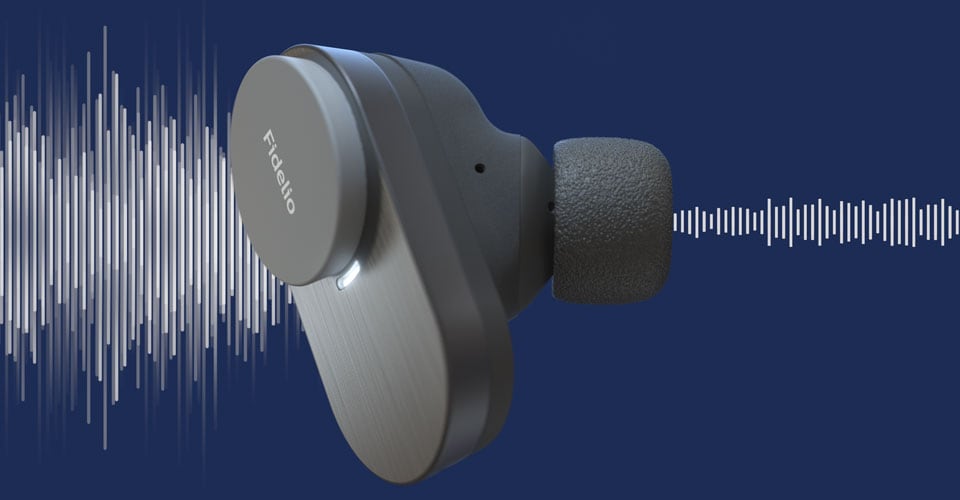
Here’s the clever bit: you can cancel a peak with a trough, and you can cancel a trough with a peak. Active noise cancellation does the exact same thing to sound waves. The ANC system in a pair of wireless noise canceling headphones records the sound waves created by unwanted noise, then creates an equal and opposite sound wave to flatten it out. The result: you won’t hear what you don’t want to hear. With no peaks and troughs left to register as sound, those unwanted sound waves simply…vanish.
If you’ve ever watched ocean waves at high tide, you might have seen something like this happening in nature. High-tide waves can bounce back off a sea wall, or a high shoreline, and flatten the peak of the waves behind them. This happens because the peak of a rebounding wave meets the trough of a wave that’s rolling in, and they cancel each other out. Sit there on that sea wall and watch, and you will actually see the waves flatten before they break.
Noise cancelling headphones can ‘hear’ what’s going on around you
So, noise cancelling headphones cancel out sound waves with other sound waves. But how does the active noise cancellation (ANC) system know which sounds to cancel? All noise cancelling headphones use mics to ‘listen’ to the sounds around you. Basically, the mic or mics record the outside noise and send this recording to the ANC system in the headphones. The ANC system then plays opposing sound waves to cancel out the unwanted stuff. The location of the mics on your noise cancelling headphones tells you what kind of ANC system you have—and each system works slightly differently.
Types of active noise cancellation systems
So which one is right for you?
There are two types of effective active noise cancellation (ANC) systems: feedback and hybrid. A feedback system offers basic noise cancellation, while a hybrid system cancels a greater range of frequencies and can self-correct.
Feedback active noise cancellation: A basic system
Feedback systems: Because a mic placed inside the ear cup or earbud can detect what your ear is hearing when you wear the headphones, the feedback system can check its own effectiveness. If external sounds become varied, the system is more able to adapt and keep the noise cancellation working effectively. On the other hand, a feedback ANC system doesn’t cancel out midrange frequencies (like speech) very quickly. That mic inside the ear cups we just mentioned?? It has to wait for sound to travel through the headphone’s physical body before it can detect it. So there’s a slight delay between the moment a noise is made, and the moment the mic picks it up. The sound can’t be cancelled until the mic has ‘heard’ it, which means you might hear the noise before the ANC system has dealt with it. To counter this, audio engineers have added an external mic to the mix—creating a hybrid active noise canceling system.
A feedback ANC system has the noise canceling mic (or mics) placed inside the ear cup or earbud (for in-ear noise canceling headphones).
Hybrid active noise cancellation: More sophisticated noise cancelling
Hybrid systems: A hybrid ANC system can more quickly recognise and mask a wider range of frequencies because the internal and external mics work together. The external mic (or mics) ‘hear’ the sounds in your environment as soon as they are made. The internal mic (or mics) then ‘listen’ to what your ear is actually hearing, just like in a feedback system. If anything from the outside world appears to have leaked into the mix, the hybrid ANC system corrects itself to give you the best possible listening experience. Hybrid ANC systems tend to appear on higher-end noise cancelling headphones like the Philips Fidelio L3 wireless noise cancelling headphones or the Fidelio T1 in-ear noise cancelling headphones.
If a pair of noise cancelling headphones have a mic (or mics) outside the ear cup or earbud, in addition to the mic (or mics) inside, then it’s using a hybrid ANC system.
Do noise canceling headphones cancel all external noise?
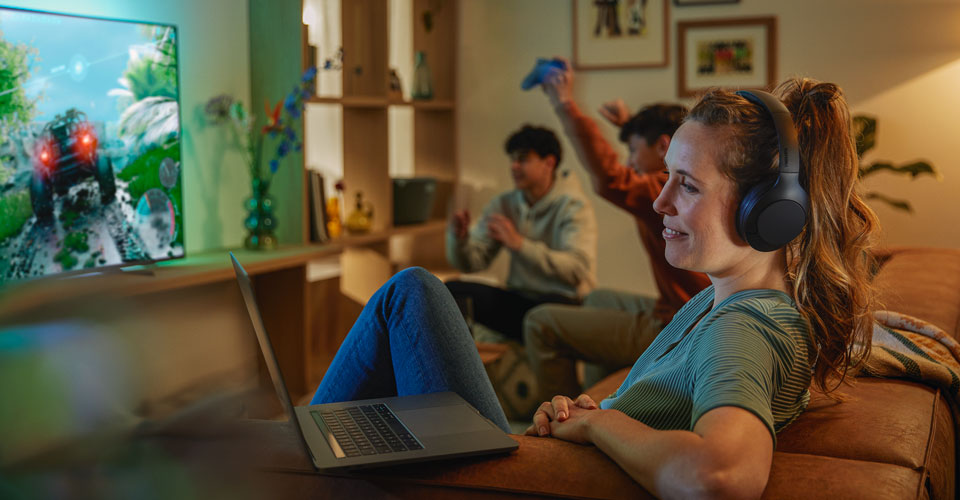
It isn’t total silence, but it’s close
Exactly how good a pair of noise canceling headphones is at canceling out external noise depends not just on which active noise cancellation system or arrangement of microphones is used, but also the intelligence of the algorithms programmed into the headphone's chipset. Needless to say, the programming of a headphone's chipset is the secret sauce in any brand's noise canceling performance but, generally, the more finely tuned the algorithm the more powerful and versatile the ANC.
The noise canceling algorithms used by Bluetooth noise canceling headphones tend to be excellent at canceling low-frequency sounds, particularly droning, ongoing noise like a train engine. They are also getting better and better at cancelling out even more mid- and high-frequency sounds, like the din of busy office environments or an airport concourse. But they find it harder to cancel out erratic or sudden noises such as things being dropped and people suddenly raising their voices nearby. It’s also important to remember that noise canceling headphones combine active noise cancellation and passive noise isolation. Passive noise isolation is very good at dampening the sounds that active noise cancellation systems struggle with. And the very best noise canceling headphones, of course, use the very best materials to passively isolate noise. High-end noise canceling headphones are able to mask most of the sounds that might otherwise make it through. You’ll be blanketed in a beautiful silence into which only your music or podcast can intrude. But every now and then you might notice something happening around you: a dog barking, perhaps, or someone dropping a tray in a café.
Which sounds can an active noise cancelling system mask?
Sound | Is it usually masked by ANC? |
| Continuous engine noise | |
| Background traffic sounds | |
| Conversational murmur | |
| Dog barking | |
| Car horn | |
| Loud shout | |
Can I change the level of noise cancellation?
Yes. A pair of wired or wireless noise canceling headphones will usually let you choose between varying strengths of noise cancellation. Generally speaking, the lowest strength is suitable for canceling noise in fairly quiet environments. A medium strength is suited to cancelling noise in less quiet environments, and a high strength would be best for canceling noise in loud places. Typically, you can cycle through the different strengths yourself using the touch controls on your headphone’s ear cups or earbud, or you can use a headphone app on your smart device. Or—if you have a pair of adaptive noise cancelling headphones—you can let your headphones do the hard work for you.
Adaptive noise canceling headphones automatically set the level of noise cancellation
In Philips noise canceling headphones with built-in adaptive noise cancellation, sophisticated algorithms detect changes in the sounds around you, and adapt the level of noise canceling in real time.
Adaptive noise cancellation works by intelligently responding to where you are, and adjusting the level of noisen accordingly. In other words: you don’t change the level of noise cancellation yourself because your headphones do it all for you.
Say you’re taking a walk in the park at lunchtime and then heading back into the office to work—your headphones will seamlessly adjust to the variations in outside noise level between streets and park, so you’ll always hear your music perfectly.
What about the external sounds you want to hear?
Most noise canceling headphones will let you pause the active noise cancellation system for a moment when you want to hear an external sound more clearly. On Philips noise canceling headphones this feature is called Awareness Mode – and it can be activated (and de-activated) instantly simply by pressing a button, or a touch-sensitive ear cup or earbud.
If you have adaptive noise cancellation turned on, your headphones will assume that you want to mask the most possible noise in your current environment. But what about those times when you want more situational awareness?

Say you’re in the office, working while immersed in your tunes, when a colleague comes over to speak to you. With Awareness Mode, you don’t need to take your headphones off: you can simply press to pause the noise cancelling system for a moment, talk to your colleague, and then press again to re-activate noise cancelling and return to your music. Or maybe you’re in a café, enjoying a coffee. You have noise cancellation turned on and the world tuned out—but the waiter comes over to your table, obviously wanting to ask a question. You activate Awareness Mode, order a pastry, and then sink happily back into whatever you’re listening to.
Philips noise canceling headphones: Which pair is right for you?
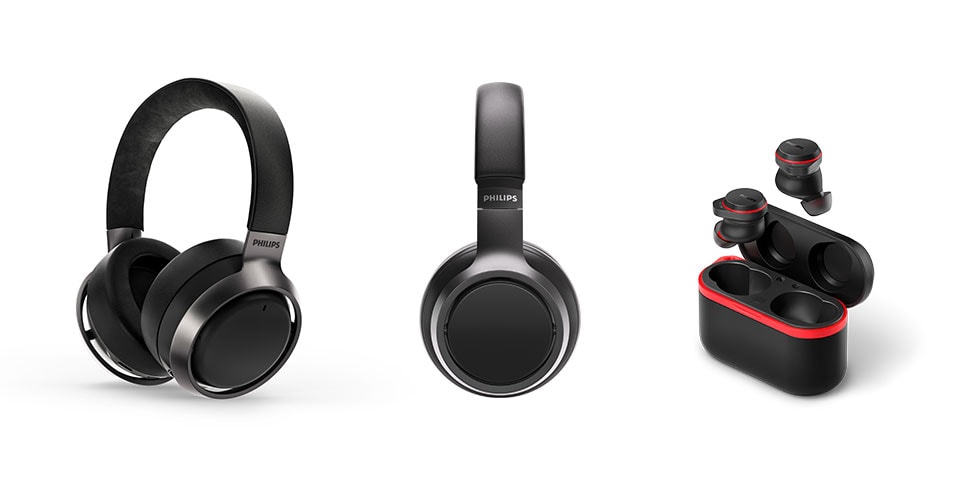
Do you simply want to quieten external noise—or do you want to turn off the world and immerse in a bubble of near-perfect silence where the only thing you can hear is the tunes you love? Choosing the right noise canceling headphones can be daunting, especially with technology constantly evolving. While we hope that our explanations above will help, we realise that it can still be confusing. Especially when you’re reading about all the great things a new pair of headphones or earbuds can do. So how do you choose?
Over-ear or in-ear noise canceling headphones—which is best?
Here at Philips, we’ve come up with three levels of noise cancellation, so you always know what you’re getting—whether you’re looking at true wireless earbuds that go in your ear, or wireless over-ear headphones. To see our full range of noise canceling headphones, click here.
The good news is that when it comes to how good the active noise cancellation is on a pair of headphones, the form factor has very little to do with it—you’re free to choose the style you prefer.
Our pick of noise canceling headphones for focus, sports, and more
The table below is your fast track to the perfect choice. These are our best noise canceling headphones for immersion, focus, and sports!
It’s common to want a pair of noise canceling headphones for a specific purpose. Perhaps you’re looking for the best noise canceling headphones for work or study, or the best noise canceling headphones for running. Or maybe you’re seriously into your music and want noise canceling headphones tuned to deliver beautifully balanced sound…whether noise cancelling is turned on or off.
| | L3—Fidelio over-ear wireless noise cancelling headphones | H8506—over-ear wireless noise canceling headphones | A7507—in-ear noise cancelling headphones |
| Noise cancellation system | Noise Cancellation Pro+ | Noise Cancellation Pro | Noise Cancellation Pro+ |
| Noise cancellation type | Hybrid ANC | Hybrid ANC | Hybrid ANC |
Awareness mode? | | | |
| Adaptive noise cancellation? | | | |
| Play time | 38 hours (32 hours with ANC on) | 60 hours (45 hours with ANC on) | Up to 29 hours with a fully charged case |
| Great for | Immersing in music whenever | The (home) office | Sports |
-
- Noise Cancellation Pro+
- Natural, balanced sound
- Leather premium design
- 38 hours play time
-
Wireless headphones
TAH8506BK/00
- Noise Canceling Pro
- Up to 60 hours play time
- Bluetooth multipoint
- Touch control
-
True wireless sports headphones
TAA7507BK/00
- Premium sound
- Noise Canceling Pro
- Crystal-clear calls
- Reliable in-ear fit



